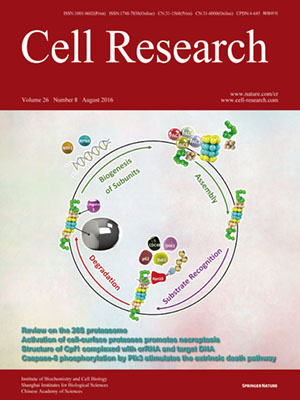
Volume 26, No 8, Aug 2016
ISSN: 1001-0602
EISSN: 1748-7838 2018
impact factor 17.848*
(Clarivate Analytics, 2019)
Volume 26 Issue 8, August 2016: 901-913
ORIGINAL ARTICLES
Type V CRISPR-Cas Cpf1 endonuclease employs a unique mechanism for crRNA-mediated target DNA recognition
Pu Gao1,2, Hui Yang2, Kanagalaghatta R Rajashankar3,4, Zhiwei Huang5 and Dinshaw J Patel2
1Key Laboratory of Infection and Immunity, CAS Center for Excellence in Biomacromolecules, Institute of Biophysics, Chinese Academy of Sciences, Beijing 100101, China
2Structural Biology Program, Memorial Sloan-Kettering Cancer Center, New York, NY 10065, USA
3Department of Chemistry and Chemical Biology, Cornell University, Ithaca, NY 14853, USA
4NE-CAT, Advanced Photon Source, Argonne National Laboratory, Argonne, IL 60349, USA
5School of Life Science and Technology, Harbin Institute of Technology, Harbin 150880, China
Correspondence: Pu Gao, E-mail: gaopu@ibp.ac.cn; Dinshaw J Patel,(pateld@mskcc.org)
CRISPR-Cas9 and CRISPR-Cpf1 systems have been successfully harnessed for genome editing. In the CRISPR-Cas9 system, the preordered A-form RNA seed sequence and preformed protein PAM-interacting cleft are essential for Cas9 to form a DNA recognition-competent structure. Whether the CRISPR-Cpf1 system employs a similar mechanism for target DNA recognition remains unclear. Here, we have determined the crystal structure of Acidaminococcus sp. Cpf1 (AsCpf1) in complex with crRNA and target DNA. Structural comparison between the AsCpf1-crRNA-DNA ternary complex and the recently reported Lachnospiraceae bacterium Cpf1 (LbCpf1)-crRNA binary complex identifies a unique mechanism employed by Cpf1 for target recognition. The seed sequence required for initial DNA interrogation is disordered in the Cpf1-cRNA binary complex, but becomes ordered upon ternary complex formation. Further, the PAM interacting cleft of Cpf1 undergoes an “open-to-closed” conformational change upon target DNA binding, which in turn induces structural changes within Cpf1 to accommodate the ordered A-form seed RNA segment. This unique mechanism of target recognition by Cpf1 is distinct from that reported previously for Cas9.
10.1038/cr.2016.88
FULL TEXT | PDF
Browse 1973


